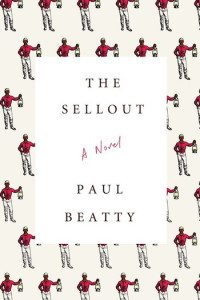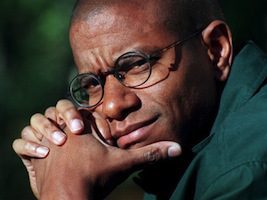
At first it seems like Paul Beatty’s new novel The Sellout may not be an ideal book to read on a crowded subway car. On one page we get a flurry of N-Words, and on the next, Hominy Jenkins, the last surviving cast member of The Little Rascals, is begging the narrator to whip him, to take him on as his slave. That’s difficult to explain if someone’s reading over your shoulder.
Even contextualized within a full synopsis of the book, the racial slurs, along with the main character’s work to resegregate the public busses and schools, are difficult to get a handle on. It’s challenging to explain the premise of Beatty’s novel, which is that maybe you can use racism to make people less racist. For example, after the narrator hangs a sign in the bus that read, “PRIORITY SEATING FOR SENIORS, DISABLED, AND WHITES” he says, “People grouse at first, but the racism takes them back. Makes them humble. Makes them realize how far we’ve come, and, more importantly, how far we have to go.” The Sellout does with race what Flannery O’Connor did with religion in books like Wiseblood. It magnifies problems until they’re absurd and hilarious.
Beatty’s narrator is raised by a fanatic sociologist father who subjects him to countless experiments, including adorning his son with a “hip-hop heavy gold chain,” expensive headphones, and a set of custom-made Honda Civic floor matts, then jamming money in his pockets for everyone to see on the busiest intersection in town. From there, the father proceeds to beat his son. What begins as an experiment to see if the “bystander effect” will apply to black people, “a loving race whose very survival has been dependent on helping one another in times of need,” ends in a group beating of the narrator. People don’t stop the father as he mugs his son. They join in. They beat the boy until he’s unconscious. And when he finally comes to, his father is conducting a survey.
“How satisfied were you with your act of selflessness?”
Not at all Somewhat satisfied Very satisfied
1 2 3 4 5
“I was his Anna Freud, his little case study,” the narrator says of his upbringing. And we see it on every page. While some kids spent time ditching class and playing with friends, the narrator works on the family’s farm right “in the middle of the ghetto” in a town called Dickens, which Beatty is quoted as saying is based on Compton.

After a weekly assembly with other local intellectuals to discuss “public advocacy” at Dum Dum Donuts, “the one place in Dickens where niggers knew how to act,” his father is shot down in the street by the police. The narrator is left to fill his father’s shoes as the town’s resident “Nigger Whisperer,” a job that requires him to meet “interesting people [and try] to convince them that no matter how much heroin and R. Kelly they had in their systems, they absolutely could not fly.” So he takes care of the farm and ultimately the town. He says, “I was my father’s child, a product of my environment, and nothing more. Dickens was me. And I was my father.”
And then Dickens is disappeared. All of the town’s signs are removed overnight. Dickens is no longer included on maps or even in the nightly weather reports. So the narrator paints and hangs his own Dickens signs. He circles the town with strip of white paint to say we’re here, this is Dickens.
It’s this work, along with his continuation of his father’s attempts to reveal the state of racism and corruption in the nation by way of the problems in the town, that get him called to trial in front of the Supreme Court. He does, after all, “own” and whip a slave, has hung the racist signs in the busses, and, among other things, castrated a cow in front of schoolchildren on career day. Most of the story seems to be told from this point, in court, waiting for the trial to begin. He’s talking to his lawyer who’s supplied him with potent weed, which may explain the dilated way the entire book feels. Maybe the narrator is high the whole time. He’s telling his story in a way that feels like he’s explaining himself to himself. He finally has the time to ask the two questions his father only ever afforded the people he was “whispering” to: “Who am I? And how may I become myself?” Or, more accurately, who are we and what are we becoming?
Toward the end, the narrator recalls a scene at Dum Dum Donuts when he and his father went to see a comedy show. The scene is lucid and quick, unlike many of the more rambling, associative stretches in the story. There is a new open-mike host who is “unpaid-electricity bill dark” and whose eyes “protruded wildly from his head like they were trying to escape the mental madness therein.” He starts the night by jumping on stage and telling the first joke the narrator has ever laughed at. From there has the narrator’s attention. Beatty writes, “This traffic-court jester did more than tell jokes; he plucked out your subconscious and beat you silly with it, not until you were unrecognizable, but until you were recognizable.” I imagine if you asked Beatty to write a blurb for his own book it’d be this quote—with “writer/ poet” subbed for “jester.” And maybe this explains why my understanding of The Sellout is similar to one’s grasp of a wave as it crests, triple-over-head, and pummels you. You feel the power but it’s difficult to explicate. You’re just trying to make it up for air.
Beatty writes, “Silence can be either protest or consent, but most times it’s fear.” And this is the reason we have to read books like this—not alone in our apartments, but standing on packed, rush-hour trains. Buy the book. Buy it in extra large print. Laugh at it in front of people. Try to explain why.




